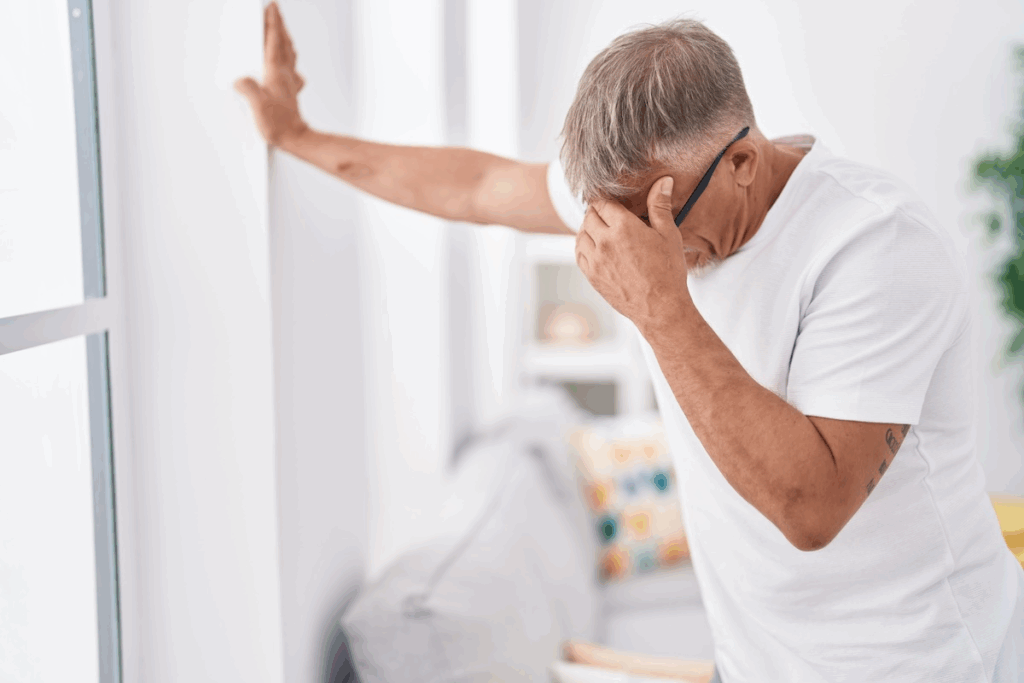Last Updated on October 31, 2025 by Bilal Hasdemir

Find the 7 best benign prostatic hyperplasia medications that work to reduce prostate enlargement and improve urinary symptoms.
Benign Prostatic Hyperplasia (BPH), or enlarged prostate, is a common issue for aging men. The NIH says BPH is the top prostate problem for men over 50. Its occurrence grows from 50 percent in men ages 50 to 60 to 80 percent by age 80.
As men get older, their prostate gland gets bigger. This can lead to urinary symptoms that really affect their life quality. It’s important to find good treatments to manage these symptoms and boost confidence. We know how vital prostate drugs and other treatments are for BPH.
At Liv Hospital, we mix international expertise with care focused on the patient. We help men navigate the latest BPH treatment options, including medications for treating bph and new, less invasive procedures. Knowing your options is the first step to feeling better.

Benign Prostatic Hyperplasia (BPH), or prostate enlargement, affects many men worldwide. It causes lower urinary tract symptoms. As men get older, their prostate gland grows, leading to urinary problems.
Knowing the causes, how common it is, and its symptoms is key to managing BPH well.
The exact cause of BPH is not known. Hormonal changes, genetics, and other factors are thought to play a role. As men age, the balance of testosterone and estrogen changes, leading to prostate growth.
Genetics also play a big part. Men with a family history of BPH are more likely to get it.
BPH is common among older men. Studies show over half of men aged 50 and older have BPH symptoms. By 80, almost all men do.
Factors that increase the risk include age, family history, obesity, and lack of exercise. Diet also plays a role.
BPH symptoms can greatly affect a man’s life. Symptoms include needing to urinate often, waking up at night, weak urine flow, and feeling like the bladder isn’t empty.
These symptoms can disrupt sleep, reduce productivity, and cause discomfort.
| Aspect | Description |
| Causes | Hormonal changes, genetics, and other factors |
| Prevalence | Over 50% in men aged 50+, up to 90% by age 80 |
| Common Symptoms | Frequent urination, nocturia, weak urine flow |
It’s important for men to understand BPH and its effects. This knowledge helps them seek the right medical care. There are treatments, like drugs that reduce prostate size, to help manage symptoms and improve life quality.

Medications are key in treating BPH. Understanding how they work helps patients make better choices. Benign Prostatic Hyperplasia (BPH) makes the prostate gland grow, causing urinary issues.
There are many types of BPH medications, each working differently. Alpha-blockers relax muscles in the prostate and bladder neck. This makes it easier to pee. Tamsulosin and alfuzosin are examples.
5-alpha reductase inhibitors shrink the prostate gland over time. This improves urine flow and reduces symptoms. Finasteride and dutasteride are well-known in this group.
Phosphodiesterase-5 inhibitors like tadalafil help with BPH and erectile dysfunction. Beta-3 adrenergic agonists like vibegron treat BPH symptoms related to an overactive bladder.
The main goal of BPH medication is to ease symptoms and enhance life quality. Expectations vary based on the medication and patient factors. Alpha-blockers offer quick relief, while 5-alpha reductase inhibitors take longer but offer lasting benefits.
Medication is often suggested for men with moderate to severe BPH symptoms. The choice between medication and other treatments depends on symptom severity, health, and personal preferences. Medications are usually chosen when symptoms greatly affect daily life.
Tamsulosin, also known as Flomax, is a top choice for BPH symptoms. It’s an alpha-blocker that helps with urinary issues from an enlarged prostate.
Tamsulosin blocks alpha-1 receptors in the prostate and bladder neck. This makes the muscles relax, improving urine flow. It quickly helps with symptoms like urinary hesitation and weak stream.
Tamsulosin offers quick relief and improves urine flow. But, it can cause side effects like dizziness and abnormal ejaculation.
Tamsulosin helps men with bothersome BPH symptoms. It’s best for those needing quick relief and looking for a medication with fewer side effects.
| Patient Profile | Benefit from Tamsulosin |
| Men with moderate to severe BPH symptoms | Significant improvement in urinary flow and symptom reduction |
| Patients seeking rapid relief from urinary difficulties | Quick onset of action, often within days |
| Men who are looking for a well-tolerated BPH medication | Tamsulosin’s selective action reduces certain side effects |
Uroxatral, or alfuzosin, is a popular choice for treating Benign Prostatic Hyperplasia (BPH). It’s known for its effectiveness and fewer side effects. Alfuzosin is taken once a day, making it easier for patients to stick to their treatment.
Alfuzosin helps relax muscles in the prostate and bladder neck. This makes it easier to urinate. It works by targeting specific receptors, improving urinary flow and reducing BPH symptoms.
One of alfuzosin’s big advantages is its once-a-day dose. This makes it simpler for patients to follow their treatment plan. This can lead to better management of BPH symptoms.
Alfuzosin is effective in improving urinary flow and reducing BPH symptoms. It also has fewer side effects compared to other alpha-blockers. But, like all medicines, it has some downsides. Common side effects include dizziness, headache, and fatigue.
Key Considerations:
Alfuzosin is best for men with moderate to severe BPH symptoms. It’s also good for those who have had bad reactions to other alpha-blockers. Alfuzosin is a well-tolerated and effective option.
| Medication | Dosing Frequency | Common Side Effects |
| Alfuzosin (Uroxatral) | Once daily | Dizziness, headache, fatigue |
| Tamsulosin (Flomax) | Once daily | Dizziness, retrograde ejaculation |
| Silodosin (Rapaflo) | Once daily | Retrograde ejaculation, dizziness |
When thinking about alfuzosin, weigh its benefits against possible side effects. Always talk to a healthcare provider about any concerns.
Silodosin (Rapaflo) is a top choice for treating severe BPH symptoms. It targets alpha-1 adrenergic receptors in the prostate and bladder. This helps improve urine flow and reduce symptoms.
Silodosin is very good at targeting alpha-1 receptors. This makes it a strong drug to reduce prostate symptoms. It relaxes muscles in the prostate and bladder, making it easier to urinate.
It works well without lowering blood pressure too much. This is good news for people who worry about blood pressure changes.
Silodosin is great for treating severe BPH symptoms. It also has fewer side effects than other alpha-blockers. But, it can cause retrograde ejaculation, which might worry some patients.
| Pros | Cons |
| Effective for severe BPH symptoms | Risk of retrograde ejaculation |
| Minimal impact on blood pressure | Potential for other side effects |
| Once-daily dosing | May not be suitable for all patients |
Silodosin is best for those with severe BPH symptoms. It’s great for those who haven’t seen results with other treatments. It’s also good for those who want a bph meds list with once-daily dosing.
Healthcare providers look at the good and bad of different drugs for prostate issues. Silodosin’s selective action and effectiveness make it a top pick for severe symptoms. It offers a good balance of benefits and safety.
Finasteride is a 5-alpha reductase inhibitor. It helps reduce prostate size and ease BPH symptoms. It works by stopping testosterone from turning into DHT, a key cause of prostate growth.
Finasteride blocks 5-alpha reductase, an enzyme that turns testosterone into DHT. High DHT levels cause an enlarged prostate. By lowering DHT, Finasteride shrinks the prostate, improving urine flow and reducing urinary retention risk.
“The reduction in DHT leads to a decrease in prostate size, which in turn alleviates the symptoms associated with BPH,” says a leading urologist. This makes Finasteride an effective prostate gland medicine for many men.
Finasteride improves BPH symptoms, lowers urinary retention risk, and may reduce surgery needs. But, it can cause side effects like low libido, erectile dysfunction, and ejaculation issues. These side effects are usually mild and may go away with continued use.
Finasteride is great for men with moderate to severe BPH symptoms and a big prostate. It’s also good for those at high risk of disease getting worse. Men should talk to their doctor about their risk factors and treatment goals to see if Finasteride is right for them.
Long-term use of Finasteride offers lasting benefits. It’s a good choice for men wanting to manage their BPH symptoms over time.
Dutasteride, also known as Avodart, is a big step forward in treating Benign Prostatic Hyperplasia (BPH). It’s a 5-alpha reductase inhibitor. This class of drugs helps by lowering dihydrotestosterone (DHT), a hormone that makes the prostate grow.
Dutasteride works in a special way. It blocks both type 1 and type 2 5-alpha reductase enzymes. This is better than finasteride because it reduces DHT more effectively. Lower DHT means a smaller prostate, which helps with BPH symptoms.
This special way of working means dutasteride can make the prostate smaller and improve urine flow better than finasteride. It’s a good choice for men with big prostates or those who didn’t get better with other treatments.
Dutasteride is very good at shrinking the prostate and easing symptoms. It’s considered one of the best BPH drugs. But, like all medicines, it can have side effects. These can include less sex drive and trouble getting an erection.
It’s important for patients to talk to their doctor about the pros and cons. This helps decide if dutasteride is right for them.
Dutasteride is best for men with moderate to severe BPH symptoms and big prostates. It’s also good for those who didn’t get better with other treatments. Starting dutasteride should be based on a full check-up, including prostate size and symptom severity.
Knowing the good and bad about dutasteride helps doctors make better choices. They can use it as part of a complete plan to manage BPH.
Tadalafil, also known as Cialis, is a key treatment for men with Benign Prostatic Hyperplasia (BPH) and erectile dysfunction (ED). It’s a PDE-5 inhibitor that helps with both conditions. This makes it a great choice for men facing these health issues.
Tadalafil relaxes the muscles in the prostate and bladder neck. This makes it easier to urinate. It also helps in achieving and maintaining an erection. This dual action makes Tadalafil a good option for men with BPH and ED.
The effectiveness of Tadalafil in treating BPH symptoms comes from its ability to relax these muscles. This reduces the blockage caused by an enlarged prostate. It improves urinary flow and reduces symptoms like a weak stream or frequent urination.
Using Tadalafil for BPH with ED comorbidity has its advantages. It can be taken once a day, providing continuous relief and improving erectile function. But, it’s important to consider side effects like headache, back pain, and indigestion.
To better understand the benefits and drawbacks, let’s examine the following table:
| Aspect | Benefits | Drawbacks |
| Mechanism of Action | Relaxes smooth muscles in prostate and bladder neck, improving urinary flow | Potential for hypotension when combined with other vasodilators |
| Dosing | Once-daily dosing for continuous relief | Daily commitment may not be ideal for all patients |
| Side Effects | Generally well-tolerated | Headache, back pain, indigestion |
Tadalafil is a great choice for men with both BPH and erectile dysfunction. It’s also good for those who want a once-daily medication for both conditions.
For men with BPH and ED, Tadalafil is a convenient option. It simplifies their medication regimen while effectively managing their symptoms.
Vibegron is a new treatment for BPH, mainly for those with overactive bladder. It relaxes the bladder muscle. This helps improve symptoms of overactive bladder.
Vibegron works differently than other BPH treatments. It targets beta-3 adrenergic receptors. This relaxes the detrusor muscle, making the bladder hold more and reducing how often you need to go.
This unique mechanism helps those who didn’t get better with other treatments. Vibegron improves urinary symptoms and boosts quality of life for BPH and OAB patients. Studies show it reduces urgency and frequency, giving patients relief.
Vibegron has benefits but also drawbacks. Common side effects include urinary tract infections and headaches. It’s important to talk to your doctor about your health history to see if Vibegron is right for you.
Another thing to think about is the cost and accessibility of Vibegron. Being a new drug, it might not be covered by all insurance. This could make it expensive for some patients.
Vibegron is great for BPH patients with overactive bladder symptoms. It’s best for those who haven’t found relief with other treatments or can’t take other BPH meds.
Doctors will decide if Vibegron is right for you based on your symptoms, medical history, and other meds. This ensures you get the best treatment for your needs.
Choosing the right medication for Benign Prostatic Hyperplasia (BPH) is key. It helps manage symptoms and improves life quality. We’ve looked at different treatments, like alpha-blockers and 5-alpha reductase inhibitors.
What medication to choose depends on how bad the symptoms are and the patient’s health. It’s important to know about all the options to make a good choice.
When picking the best BPH drugs, weighing the good and bad points is important. This helps doctors create treatment plans that fit each patient’s needs.
Finding the right medication can greatly help men with BPH. By knowing about the different treatments, patients and doctors can work together to find the best one.
BPH, or enlarged prostate, is when the prostate gland gets bigger. This can cause urinary problems. It’s very common in older men, affecting 50% of men between 50 and 60. By 80, it affects 80% of men.
Hormonal changes, like testosterone turning into DHT, and genetics cause prostate enlargement. Age and family history also play a role.
Alpha-blockers, like tamsulosin, relax prostate and bladder muscles. This makes it easier to pee. They help with weak urine flow and frequent need to pee.
5-alpha reductase inhibitors, like finasteride, block DHT production. This hormone makes the prostate grow. By reducing DHT, these drugs can shrink the prostate, easing urinary symptoms.
Tamsulosin quickly relieves BPH symptoms by relaxing muscles. Common side effects include dizziness, headaches, and issues with ejaculation.
Silodosin is very effective for severe BPH symptoms. It has more side effects like issues with ejaculation than tamsulosin.
Yes, finasteride and dutasteride can cause side effects like low libido and erectile dysfunction. But these are rare and may lessen over time.
Tadalafil treats erectile dysfunction and also helps with BPH symptoms. It’s great for men with both conditions.
Vibegron relaxes the bladder muscle, increasing capacity and reducing urination frequency. It’s for BPH symptoms in patients with overactive bladder.
Choosing the right BPH medication depends on your symptoms, health, and other conditions. Always talk to a healthcare provider to find the best treatment for you.
Yes, lifestyle changes can help with BPH medication. Try dietary changes, more exercise, manage fluid intake, and avoid caffeine and alcohol. These can ease symptoms and improve prostate health.
National Center for Biotechnology Information. (2025). 7 Best BPH Medications to Reduce Prostate Enlargement. Retrieved from https://www.ncbi.nlm.nih.gov/books/NBK558920/[1
Subscribe to our e-newsletter to stay informed about the latest innovations in the world of health and exclusive offers!
WhatsApp us